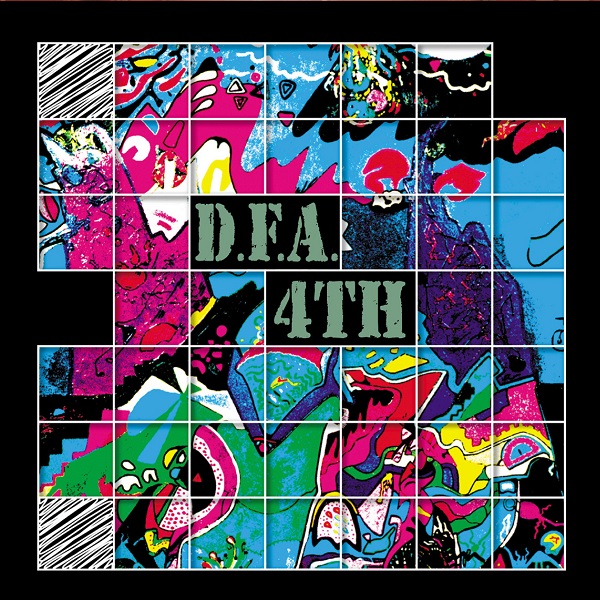
Exposé Online
What's old
Exposé print issues (1993-2011)
- 1 (October 1993)
- 2 (February 1994)
- 3 (May 1994)
- 4 (August 1994)
- 5 (October 1994)
- 6 (March 1995)
- 7 (July 1995)
- 8 (November 1995)
- 9 (March 1996)
- 10 (August 1996)
- 11 (February 1997)
- 12 (May 1997)
- 13 (October 1997)
- 14 (February 1998)
- 15 (July 1998)
- 16 (January 1999)
- 17 (April 1999)
- 18 (November 1999)
- 19 (May 2000)
- 20 (October 2000)
- 21 (March 2001)
- 22 (July 2001)
- 23 (December 2001)
- 24 (April 2002)
- 25 (September 2002)
- 26 (February 2003)
- 27 (August 2003)
- 28 (December 2003)
- 29 (April 2004)
- 30 (September 2004)
- 31 (March 2005)
- 32 (September 2005)
- 33 (May 2006)
- 34 (March 2007)
- 35 (January 2008)
- 36 (October 2008)
- 37 (July 2009)
- 38 (July 2010)
- 39 (Summer 2011)
Reviews
D.F.A. — 4th
(Moonjune MJR021, 2008, CD)

It may have been close to ten years since DFA’s last studio album, but this band has certainly not lost their edge; in fact, if anything the intensity and passion in this new set makes up for all the lost time. Still a quartet of guitars, bass, drums, and multi-keyboards, the furious energy of the first few cuts – including a sidelong opener, sound like they are channeling the spirit of National Health and Zappa’s Grand Wazoo band through the jazz-rock prism of Arti e Mestieri with a bit of Mahavishnu in the mix. No holds barred, this is a burning cauldron of melodic instrumental fusion, though retaining much of the feeling and beauty of progressive rock that made so many classic Italian bands of that genre so special (think Arti, Perigeo, Area, Etna, and so many others). On the fourth cut, “Mosoq Runa” – another sidelong piece – they introduce some guest string players who add a whole new dimension to the sound, along with keyboardist Alberto Bonomi’s tasty orchestrations. The final two cuts add the dimension of vocals to this already rich blend of melodic elements – first from drummer Alberto de Grandis on “The Mirror,” and then on the closing cut from the three-piece female vocal unit Andhira. This is, quite simply put, DFA’s most satisfying and superb effort to date. Highly recommended.
by Peter Thelen, Published 2008-10-01
As previously mentioned, the great DFA's career was cut short due to tragedy; musically speaking the band's last effort was as amazing as its first. I've mentioned elsewhere on a number of occasions that as many great new Italians bands there are giving tribute to their influences in the 70s, one thing often missed is that many newer bands tend to fill empty seats with musicians who grew up on rock and metal when so many of the chairs in the 70s were filled by musicians who knew jazz and could make the band sound really swing and groove. While DFA isn't technically doing the same thing because of their wider palette of influences, they're still a great example of what it's like when a band is attempting progressive rock with a group of players who know how to swing with the rhythm instead of chopping through it all with rock beats, and that actually tends to liken DFA a bit closer to the Canterbury bands of the 70s. However, the tricky rhythm changes, the dexterous unison lines and start/stop twists, all features of fusion and progressive rock, are still part of the style here, they're just so fluidly run through that there's no groove lost no matter how complicated it is. The chemistry of this band by this album was just thoroughly unstoppable, it was as if they could do anything they wanted and it's really noticeable how the collective musicianship had grown by this point. In a genre where the swansong of a band usually comes after the sound had been watered down due to commercial influences, DFA's career ended on an uncommonly high note. It's rare that you get to see this kind of farflung musical ambition with such instrumental maturity and taste.
by Mike McLatchey, Published 2017-07-13
Filed under: New releases, Issue 36, 2008 releases
Related artist(s): D.F.A.
What's new
These are the most recent changes made to artists, releases, and articles.
- Review: Earthbound - Earthbound
Published 2025-12-28 - Review: Olgoj - A Place to Rest
Published 2025-12-27 - Release: John Weider - John Weider
Updated 2025-12-26 19:13:54 - Artist: John Weider
Updated 2025-12-26 19:09:52 - Release: Moonrider - Moonrider
Updated 2025-12-26 18:51:45 - Artist: Moonrider
Updated 2025-12-26 18:49:51 - Release: Octopus Syng - Insanity Is the Song We Sing
Updated 2025-12-26 12:53:35 - Release: Tre Spiritus - Tre Spiritus
Updated 2025-12-26 12:49:13 - Artist: Tre Spiritus
Updated 2025-12-26 12:48:34 - Release: Arpia - Festa Grande
Updated 2025-12-26 12:42:27 - Release: Sigmund Freud - Risveglio
Updated 2025-12-26 12:37:54 - Artist: Sigmund Freud
Updated 2025-12-26 12:37:08 - Release: Davide Cedolin - Ligurian Pastoral, Vol II
Updated 2025-12-26 00:17:38 - Release: Davide Cedolin - Ligurian Pastoral
Updated 2025-12-26 00:15:05 - Artist: Davide Cedolin
Updated 2025-12-26 00:12:01 - Review: Kokkinià - The Last Are Lost from the List
Published 2025-12-26 - Review: Pymlico - Core
Published 2025-12-25 - Release: Various Artists - Soul of the Machine: A Celebration of the Life & Legacy of ARP Founder Alan R Pearlman
Updated 2025-12-24 15:58:08 - Review: Jussi Reijonen - Sayr: Salt / Thirst & Sayr: Kaiho – Live in Helsinki
Published 2025-12-24 - Review: TOC & Jean-Luc Guionnet - Quelques Idées d'un Vert Incolore Dorment Furieusement
Published 2025-12-24
